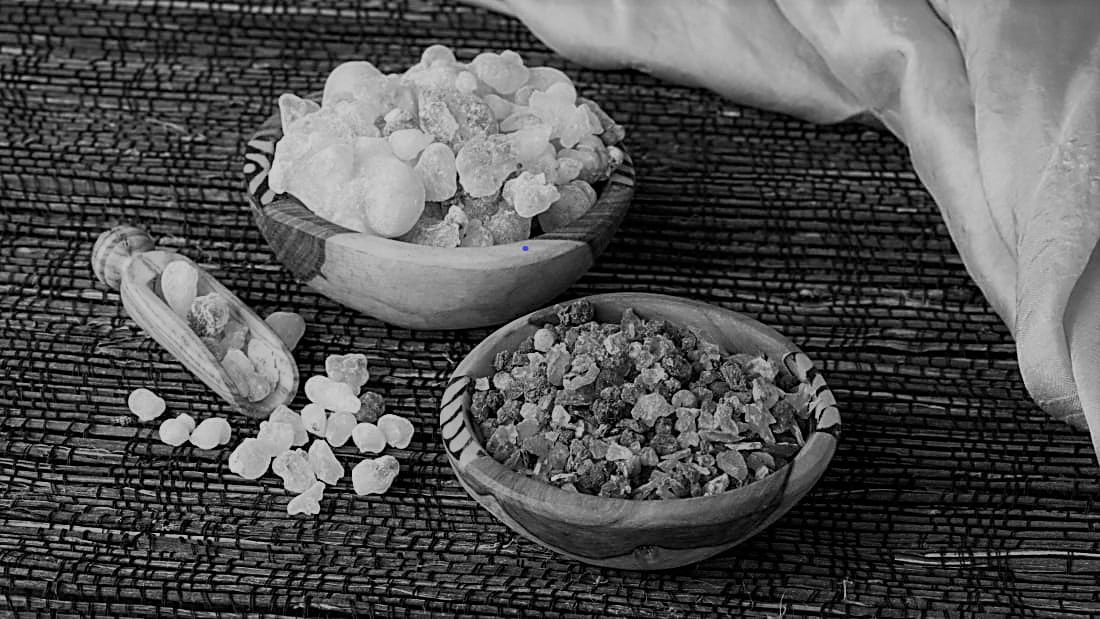In studying Isaiah a while back, I had made a note about a well-known, messianic verse:
But he was pierced for our transgressions,
Isaiah 53:5 NIV
he was crushed for our iniquities;
the punishment that brought us peace was on him,
and by his wounds we are healed.
This verse is visceral—it grabs our emotions, we can imagine its raw, physical effect, and as believers can we humbly appreciate the eternal, spiritual cost of the peace and healing Jesus won for us through His sacrifice.
But it is those words—pierced, crushed—that I want to focus upon.
This is what I realized—the gifts of the Magi, frankincense and myrrh in particular, are harvested in ways that clearly echo this prophetic declaration from Isaiah. Even their healing applications mimic the Savior. Their gifts, in light of this verse, were intended to openly acknowledge the young King’s imminent sacrifice as the Suffering Servant.
If you’ve watched the video, you remember that I discussed how the Magi had been led and trained by Daniel, the prophet who served the Babylonian and later Persian kings during the period of Judean captivity. I suggested that the Magi may well have read the writings of other Judean and Israelite prophets, including Isaiah, who was well-regarded (2 Kings 19:5, 2 Kings 20:4-11) in his time (until Hezekiah’s son, Manasseh came to power).
The first of the two gifts, frankincense, has a curious method of harvesting. The fragrance contained in the gum resin of the tree. To extract the resin, the bark of the tree is peeled back, and the tree is repeatedly stabbed—pierced, if you will—with a special knife, creating an oval-shaped wound. The resin then flows freely to the surface of the tree creating small, white drips—in fact, these resin drops are also called “tears of the sun”.[1]
Think now about Jesus’ trial and crucifixion. Mark and Matthew both tell of how Pilate orders Jesus to be flogged: Wanting to satisfy the crowd, Pilate released Barabbas to them. He had Jesus flogged, and handed him over to be crucified. (Mark 15:15, NIV). Flogging is a brutal punishment, where a person is stripped down and beaten, repeatedly, by a whip studded with pieces of sharp bone or metal. The punishment is so severe that the victim’s skin tears or peels away, exposing organs and excessive blood loss often causes death.
Jesus is later pierced after He is crucified, to ensure that He has died: Instead, one of the soldiers pierced Jesus’ side with a spear, bringing a sudden flow of blood and water. (John 19:34, NIV).
Both the flogging and the piercing are eerily replicated through the process of harvesting frankincense. It’s no wonder that Paul refers to Jesus’ crucifixion as “a fragrant offering and sacrifice to God” (Ephesians 5:2, NIV). Frankincense is a shadow and form of Lord Jesus. Its purpose in the Tabernacle was to create Ketoret, the fragrant, consecrated incense set apart only to burn in God’s Presence.
Let’s look now at myrrh, the second gift I mentioned earlier. Like frankincense, myrrh comes from the gum resin of a tree. Also, accessing the gum comes through making deep wounds in the bark, making the tree “bleed”. The droplets harden over a period of months, producing fragrant globes. To fully release the fragrant beauty of myrrh, however, those tears must be crushed and mixed with oil.
Oil, as we well know, is used in anointing, and symbolizes the anointing of Holy Spirit. God instructed Moses to anoint the Tabernacle, the Ark, all of the articles of fellowship and offering, and the priests who ministered to God with the sacred oil meant only to honor God.
In myrrh, we have a beautiful connection to the agape, the divine love of Jesus on display at the passion and the cross. Jesus is crushed in punishment and mocking by the soldiers at the Praetorium. In His burial, Jesus is anointed in myrrh. In His resurrection, Jesus is anointed by Holy Spirit to eternal sovereignty.
Our peace and healing are ‘harvested” through Jesus’ piercing for our sins, through Jesus’ being crushed for our evil. The frankincense and myrrh trees reflect Jesus as the Tree of Life: their sap, like His blood; the aging, like His burial; their fragrance, when set to fire, like Jesus’ sacrifice (Ephesians 5:2). Their healing properties are a pale reflection of Jesus’ complete and limitless capacity to heal us.
[1] Coder, Kim D. (2016). “Frankincense & Myrrh: Gifts of Tree History”. https://bugwoodcloud.org/resource/files/15226.pdf

Enjoyed the insight and parallels. Thank you!!!!!
Greetings! Very useful advice in this particular article! Its the little changes that will make the largest changes. Many thanks for sharing!
Thank you for taking the time to share your thoughts! I am fascinated with how God reveals Himself with echoes in nature. Have a blessed day, my friend!
Heya i’m for the first time here. I found this board and
I find It really useful & it helped me out much. I hope to give something
back and aid others like you helped me.
Thanks for your kind comment and for visiting the website. Blessings to you!